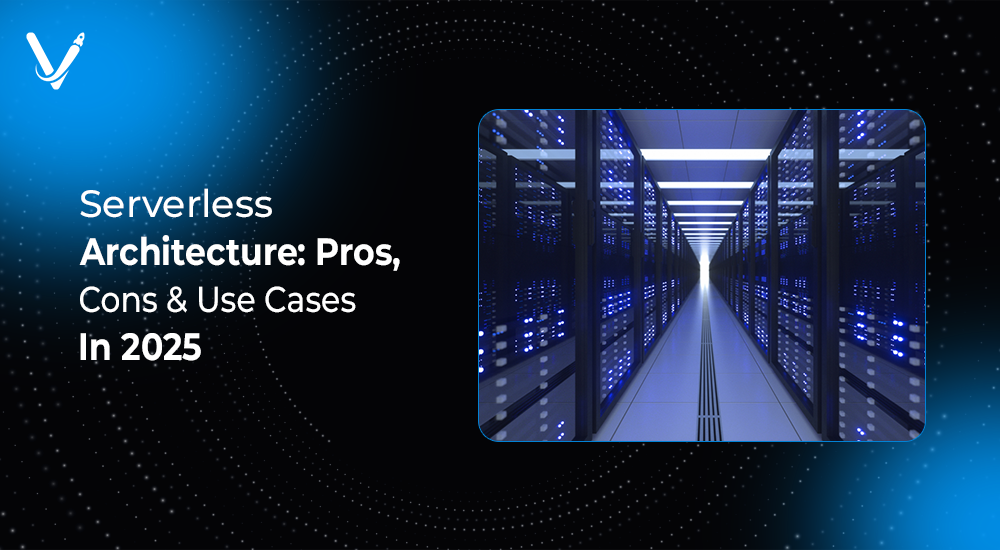Serverless Architecture: Pros, Cons & Use Cases in 2025


- Aug 16, 2025



The world of cloud computing has never stood still. In just a few years, we’ve seen businesses move from managing on-premise servers to embracing cloud-hosted infrastructure, and then to containerized applications that make deployment faster and more flexible. Now, another paradigm shift is defining the way digital products are built and scaled: serverless architecture.
Despite the name, serverless does not mean the absence of servers. Instead, it refers to a cloud-native execution model where developers write and deploy code without worrying about provisioning, maintaining, or scaling servers. The cloud provider takes full responsibility for handling infrastructure tasks like scaling, load balancing, and monitoring. Developers can focus entirely on writing business logic while the platform ensures everything runs smoothly behind the scenes.
By 2025, serverless has matured into a mainstream approach for startups, enterprises, and government systems alike. As organizations look for agility, cost efficiency, and reduced operational overhead, serverless is proving to be a key enabler. This blog takes a deep dive into the pros, cons, and use cases of serverless architecture in 2025, helping you understand when it’s the right choice and when it might not fit.
At its core, serverless architecture is a way of building and running applications without managing servers directly. The cloud provider automatically allocates resources, scales them up or down, and charges only for what you use.
Today, serverless is most commonly associated with Function-as-a-Service (FaaS) platforms like AWS Lambda, Azure Functions, and Google Cloud Functions. However, the term has expanded to include Backend-as-a-Service (BaaS) solutions, where cloud providers manage backend services such as authentication, databases, and file storage.
Serverless applications are composed of functions that run in response to triggers. These functions live inside a managed runtime environment provided by cloud vendors.
Because infrastructure is abstracted away, developers don’t need to manage server provisioning, OS patching, or scaling policies. Instead, they focus on writing modular functions that can be stitched together into larger applications.
Serverless frees developers from server management tasks like provisioning, patching, and monitoring. This enables smaller teams to deliver enterprise-grade applications without dedicated DevOps staff.
The pay-per-execution model ensures you only pay for what you use. For workloads with unpredictable traffic, serverless can drastically reduce costs compared to running idle servers.
By offloading infrastructure concerns, developers can focus on core business logic. This accelerates feature delivery, experimentation, and iteration cycles.
Serverless platforms scale functions automatically based on demand. An app can handle spikes of thousands of requests per second without downtime or manual configuration.
Teams can leverage managed services like authentication, storage, and messaging queues. This reduces boilerplate code and empowers developers to focus on innovation.
Cloud vendors provide redundancy and fault tolerance as part of serverless platforms, reducing the risk of downtime.
By allocating compute resources dynamically, serverless reduces idle capacity and lowers energy consumption, aligning with sustainability goals.
When a function hasn’t been invoked recently, the platform may take extra time to spin it up. This “cold start” delay can affect performance for latency-sensitive applications.
Functions often have strict execution timeouts (e.g., 15 minutes on AWS Lambda). This makes serverless unsuitable for long-running tasks.
Applications built on proprietary serverless services can be difficult to migrate to other providers. This creates dependency risks for businesses.
Since functions run in highly abstracted environments, traditional debugging and performance monitoring tools may not work as effectively.
Because serverless functions are stateless, developers must design around external storage solutions to maintain state, adding complexity in architecture.
While cost-effective for variable workloads, consistently high traffic may make serverless more expensive than traditional dedicated infrastructure.
Serverless is ideal for processing event streams from IoT devices, logs, or clickstreams. Functions can analyze and transform data in near real time.
Serverless functions power lightweight APIs and microservices architectures. They scale effortlessly and support rapid feature iteration.
From sending notifications to syncing data between systems, serverless excels at automating recurring workflows with minimal overhead.
Functions can process images, transcode videos, or generate thumbnails on demand, making serverless popular in media-heavy applications.
With serverless, conversational interfaces scale instantly to handle thousands of users, while only charging for active usage.
Serverless backends provide APIs, authentication, and file storage for mobile apps, reducing the need for full-stack server maintenance.
By leveraging serverless for transaction processing, fraud detection, and personalized recommendations, businesses ensure both scalability and agility.
As organizations scale their digital infrastructure in 2025, one of the most common debates is whether to rely on traditional cloud models such as Infrastructure-as-a-Service (IaaS) or containers, or to adopt serverless computing. Both approaches have unique strengths and limitations.
Traditional cloud models give businesses more control and flexibility, while serverless emphasizes simplicity, cost efficiency, and scalability. The choice often depends on workload type, business goals, and the level of operational control a team requires.
| Aspect. | Traditional Cloud (IaaS/Containers) | Serverless Architecture |
| Infrastructure Management | Requires manual provisioning, patching, and scaling of servers or containers | Fully managed by the cloud provider, no server management needed |
| Cost Model | Pay for allocated resources, even when idle | Pay-per-use, charged only for execution time |
| Scalability | Needs configuration of auto-scaling policies, scaling is not always instant | Automatic, near-infinite scalability based on demand |
| Control | Full control over environment, OS, and dependencies | Limited control, relies on vendor-managed runtime |
| Performance | Predictable, no cold start delays | May face cold start latency for idle functions |
| State Management | Supports stateful applications with persistent environments | Stateless by design, external storage required for persistence |
| Use Case Fit | Best for long-running processes, stateful workloads, and custom infrastructure needs | Ideal for event-driven, unpredictable workloads and rapid prototyping |
In 2025, many organizations adopt a hybrid approach, using serverless for event-driven, scalable workloads while relying on containers for stateful or performance-critical applications.
By 2025, serverless is evolving beyond simple function execution. Cloud providers are offering stateful serverless services, multi-cloud portability, and AI-driven optimization for performance and cost management. As organizations prioritize agility, sustainability, and innovation, serverless is emerging as the default for many digital-first strategies.
We can expect deeper integration of serverless with edge computing, enabling functions to run closer to users for ultra-low latency. In addition, AI-powered scaling algorithms will make serverless even more efficient, predicting workload demands before they occur.
Serverless architecture is no longer a futuristic concept—it’s a powerful reality in 2025. Its benefits in agility, scalability, and cost efficiency make it a strong fit for many modern applications, particularly event-driven and unpredictable workloads. However, it does come with trade-offs like vendor lock-in, cold starts, and limited control, meaning it’s not a one-size-fits-all solution.
For organizations looking to innovate faster and reduce infrastructure burdens, serverless is a game-changing approach. At Vasundhara Infotech, we help businesses evaluate, design, and implement serverless solutions that maximize efficiency while minimizing risks. If you’re ready to explore the potential of serverless for your digital products, our experts are here to guide you every step of the way.
Copyright © 2025 Vasundhara Infotech. All Rights Reserved.